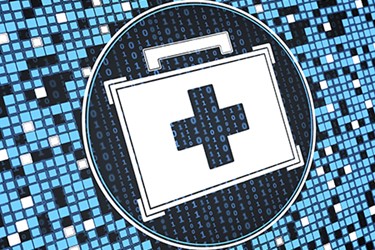Unlocking The Potential Of Real-World Data: Tapping Into Today's Data To Improve Healthcare Tomorrow
By Christoph Koenen, M.D., Bristol-Myers Squibb, and Danny Wiederkehr, Pfizer

Modern healthcare is undergoing a huge shift in how key stakeholders, including biopharmaceutical companies, health systems, and medical authorities, are approaching and evaluating patient data. An instigator for this shift is the growing access to and general use of real-world data, such as de-identified patient data collected and analyzed from registries, electronic health records, wearable devices, and administrative and healthcare claims databases. This type of data is increasingly being utilized by industry representatives to help inform drug development, health system operations, formularies and resulting coverage, and patient care decisions.
In addition to the mounting presence of real-world data across the healthcare landscape, real-world data has also been a focus for lawmakers within the United States. In December 2016, a landmark piece of legislation known as the 21st Century Cures Act was passed by Congress, which included direction for the Secretary of the U.S. Department of Health and Human Services to work with the FDA to establish a program to evaluate the potential use of real-world evidence for two reasons: to help support the approval of a new indication for a previously approved drug and to help support or satisfy post-approval study requirements.
Since then, FDA Commissioner Dr. Scott Gottlieb has expressed his support for the use of real-world data and evidence in the FDA. Most recently, the FDA’s 2018 funding requests includes a portion focused on investing in digital health and real-world data. Specifically, the requests reflect priorities to “establish a new capability ... to conduct near-real-time evidence evaluation down to the level of individual electronic health records for at least 10 million individuals in a broad range of U.S. healthcare settings.”
This ongoing authority support may give real-world data a role in helping to identify clinical or investigative areas of need, influencing trial protocol development, evaluating products post-market, informing potential indications for existing drugs, functioning as a component of regulatory considerations, as well as identifying patterns of use among approved medicines.
In September 2017, Gottlieb expressed his commitment in a statement to the National Academy of Sciences, highlighting reasons why this category of data is a top priority for the FDA and a vital aspect of the healthcare decision-making process for many across the industry. Within the statement he specifically noted that “more widespread use of [real-world data] can make our medical product development process more efficient and help lower the cost of development. More importantly, it can help make sure doctors and patients are better informed about the clinical use of new products, enabling them to make more effective, efficient medical choices.”
Defining Real-World Data
According to the FDA, real-world data is data relating to patient health status and/or the delivery of healthcare routinely collected from a variety of sources. This data is derived from sources of larger data sets, including de-identified electronic health records, insurance claims databases, health-monitoring devices, and patient registries. The sources of databases used for some of the largest scale analyses include large private national health plans, integrated delivery network electronic health records, the U.S. Department of Defense Military Health System, and the Centers for Medicare & Medicaid Services, to name a few.
At its core, real-world evidence is generated through the analysis of data collected in “real” patient and provider settings. While traditional clinical trials evaluate a medicine’s safety and efficacy in a controlled setting and within well-defined, protocol-driven parameters, real-world data analyses can explore a medicine’s safety and effectiveness when prescribed and used among a broader range or subgroup of patients. Subsequently, real-world data can offer insights on routine clinical practices that are not always possible or practical to capture in the controlled environments found in clinical trials. Though real-world data cannot be used on its own to demonstrate efficacy and safety, nor argue causality, it can evaluate associations and thereby help many across the healthcare field supplement their medical decisions.
Similarly, real-world data analyses can help identify areas in greatest need of additional data and provide insights that may help design better, more efficient clinical trials that can ultimately help patients get the right medications sooner. These findings are not limited to patient outcomes, but also offer new lines of sight into important aspects for the care experience, such as cost.
As Gottlieb and the FDA have suggested, this wealth of data has the potential to change the drug development, evaluation, review, and approval processes for the better. By analyzing data from millions of people, we can better identify the most suitable patients to enroll in ongoing and upcoming trials. Within the statement to the National Academy of Sciences, the FDA also warned that it must be realistic about current limitations to this data, stating, “[Real-world evidence] won’t replace data from traditional clinical trial data in many cases. But we can achieve more opportunity in the pre- and post-market context to use [real-world evidence] in settings where doing so will improve medical product development.”
Real-World Data In The “Real World”
Real-world data can be used by many within the healthcare system, from physicians to drug developers to payers. One example of how payers can use the data is by analyzing insurance claims to help identify cost offsets elsewhere in the healthcare system. While a clinical trial may not evaluate a broad range of outcomes such as hospitalizations for a given condition, real-world data can provide fresh perspectives on where a medication or interventions could impact patient outcomes, as well as reduce expenditures in other settings of care. This can be particularly helpful information for patients, as well as formulary decision makers, when there are multiple treatment options within the same drug class.
By looking across data sets for hundreds of thousands of patients via patient registries, databases, and electronic health records, researchers can easily highlight where a drug is associated with value or improved clinical outcomes. This growing advantage also allows us to investigate larger groups of people and further narrow in on subgroups of patients that would have potentially been excluded from requirements of clinical trials, including patients with chronic diseases or those for whom an experimental medication may not be appropriate.
Drug developers can also use this data to better understand their medicines and the patient populations they serve. The Bristol-Myers Squibb-Pfizer Alliance is fully committed to real-world data evaluation, emphasizing multi-source data collection and pooling de-identified patient data of several hundred thousand records across multiple studies. The Alliance’s ongoing work in these investigations will help inform and improve our understanding of how patients are cared for, treated, and, ultimately, doing in the real world.
Marking the impact of healthcare decision making in this digital age, the FDA published an article in December 2016 in the New England Journal of Medicine highlighting the exponential growth seen in access to patient data and its effect so far on the healthcare system. In this article, Dr. Tom Frieden, the former director of the U.S. Centers for Disease Control and Prevention, expressed that randomized controlled trials can establish a drug’s efficacy, while data from real-world observations are useful to refine dosages and identify side effects, especially rare ones.
Virtually Boundless Data Does Not Come Without Limitations
The potential benefits of having access to this scale of data also come with the need for standards and guidelines in place and subsequently followed. Unlike the highly regulated, protocol-driven controlled clinical trials, real-world data can be prospective or retrospective observational studies that lack randomization. These evaluations can only analyze associations and not causality, which can add a level of uncertainty in interpreting and acting upon results, which are vulnerable to biases and inconsistencies across reporting. Subsequently, real-world data analyses have several limitations. For example, due to the lack of control and inability to proactively or prospectively select patients, the overall process for collecting and analyzing real-world data limits the randomization of patient populations often utilized in clinical trial settings and therefore can potentially lead to confounding bias. It is important to note that the generalizability of findings may be limited to a study population. Additionally, not all data is routinely made available in these analyses, such as lab values collected during routine patient interactions, subjecting these analyses to limitations due to missing data or potential coding errors.
Limitations can also be attributed to a lack of common technologies used across institutions that collect the initial patient data. Due to these limitations, real-world data analyses cannot be used as evidence to validate the efficacy and/or safety of a treatment.
While formal regulatory guidance for real-world data use in clinical or prescribing decisions remains limited, in a promising sign of change to come, the FDA recently issued a guidance, Use of Real-World Evidence to Support Regulatory Decision-Making for Medical Devices. This guidance marks a leading medical authority’s recognition of the importance of including this valuable data in the healthcare decision-making process and brings the broader healthcare field closer to the prospect of draft guidelines to help the drug development process evolve.
Additionally, emerging methods and standards such as common data models and natural language processing can help address some — but not all — limitations of real-world data. While these efforts can better extract relevant information from raw data sources, transparency with respect to methods and reproducibility remain core to the promise of real-world data.
Looking Ahead To Unlock The Potential Of Real-World Data
In recent years, real-world data has become more prevalent at medical congresses around the globe, an indicator of the growing acceptance and relevance of real-world data to the clinical community. With this, real-world data has ultimately proven to be of interest among medical authorities, further allowing healthcare providers to have access to new insights that were previously untapped in randomized clinical trials. As Gottlieb alludes to in his February statement, evolving technology and methods, such as natural language processing, allow for information from unstructured data to be analyzed more efficiently, suggesting that real-world data will continue to become more meaningful and actionable by regulators and providers alike.
The future uses of real-world data are endless. We’re living during a technology boom, with unprecedented access to large amounts of shareable data from diverse sources. As technology and healthcare systems continue to integrate digital records, they unlock the potential for greater access to patient and provider data and ultimately may strengthen real-world data’s role in improving patient care.
About the Bristol-Myers Squibb and Pfizer Alliance
In April 2007, Bristol-Myers Squibb Company and Pfizer Inc. announced a worldwide commercial collaboration to study and develop compounds for the prevention and treatment of a broad range of venous and arterial thrombotic conditions. The Bristol-Myers Squibb and Pfizer Alliance is committed to driving education and awareness around stroke related to atrial fibrillation, as well as venous thromboembolism. With its long-standing cardiovascular leadership, global scale and expertise in these areas, the Alliance strives to implement global, research-driven approaches to identify and address the unmet needs related to non-valvular atrial fibrillation, which often results in fatal or debilitating consequences. Through collaborations with leading academic institutions and patient-centric nonprofit organizations, the Alliance aims to provide patients, physicians, and access decision makers with the information they need to take appropriate action on reducing risk factors associated with stroke and other cardiovascular conditions.
About The Authors:
 Christoph Koenen, M.D., heads all cardiovascular development, as well as CV Medical, at BMS. Since joining in 2011, he has worked in different medical and development functions within Europe and the U.S. Dr. Koenen joined BMS from Novo Nordisk, where his last position was VP and head of Global Medical Affairs. He worked on the development of several compounds for Novo Nordisk, including three different insulin compounds, and launched several successfully. Before joining Novo Nordisk in 2002, Dr. Koenen worked for GlaxoSmithKline in London (UK) and Germany, and was responsible for the development of anti-diabetic compounds.
Christoph Koenen, M.D., heads all cardiovascular development, as well as CV Medical, at BMS. Since joining in 2011, he has worked in different medical and development functions within Europe and the U.S. Dr. Koenen joined BMS from Novo Nordisk, where his last position was VP and head of Global Medical Affairs. He worked on the development of several compounds for Novo Nordisk, including three different insulin compounds, and launched several successfully. Before joining Novo Nordisk in 2002, Dr. Koenen worked for GlaxoSmithKline in London (UK) and Germany, and was responsible for the development of anti-diabetic compounds.
 Danny Wiederkehr is the global lead for the Health Economics and Outcomes Research (HEOR) Team supporting cardiovascular medicine at Pfizer. During his eight years with Pfizer, he has held several roles within Field Medical, Global Policy, and Real-World Data and Analytics, oriented around more fully leveraging data to drive engagement, insight, and strategy. Prior to joining Pfizer, Wiederkehr led several life science consulting teams. He has published over 80 analyses using healthcare claims databases, electronic health records, and national health surveys, and holds a master’s of public health in health policy and management from Columbia University.
Danny Wiederkehr is the global lead for the Health Economics and Outcomes Research (HEOR) Team supporting cardiovascular medicine at Pfizer. During his eight years with Pfizer, he has held several roles within Field Medical, Global Policy, and Real-World Data and Analytics, oriented around more fully leveraging data to drive engagement, insight, and strategy. Prior to joining Pfizer, Wiederkehr led several life science consulting teams. He has published over 80 analyses using healthcare claims databases, electronic health records, and national health surveys, and holds a master’s of public health in health policy and management from Columbia University.
